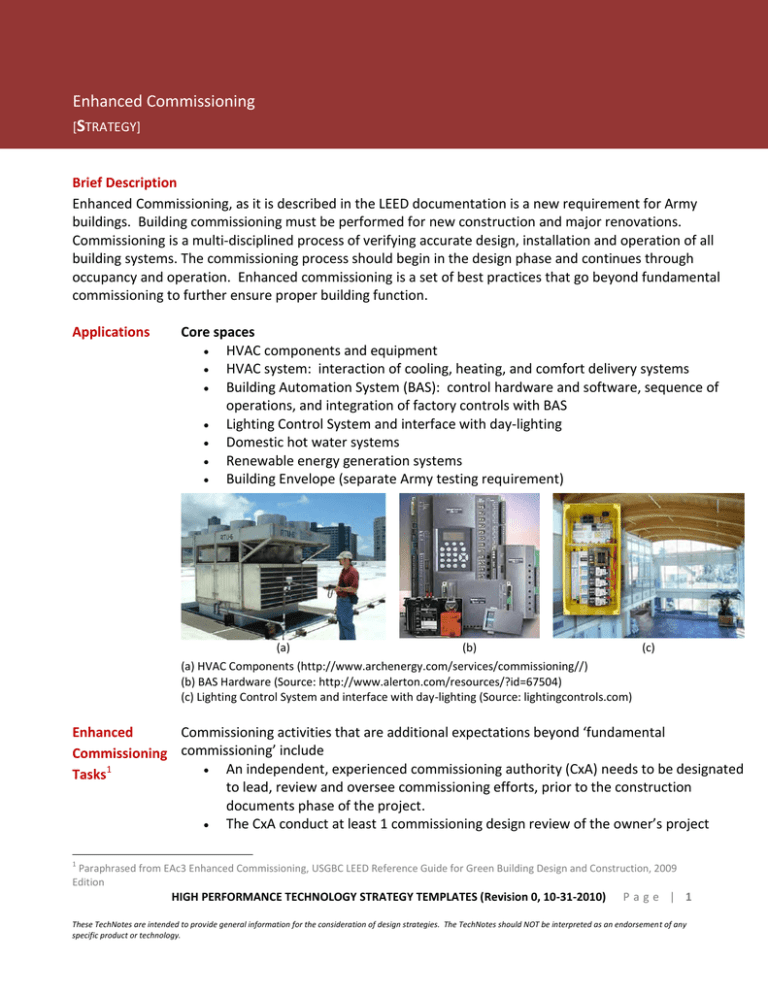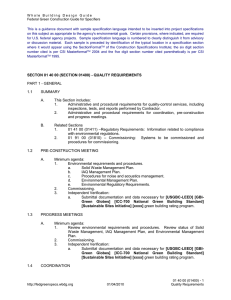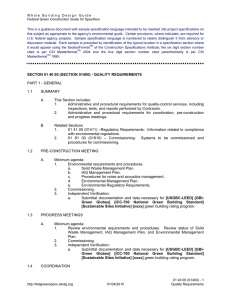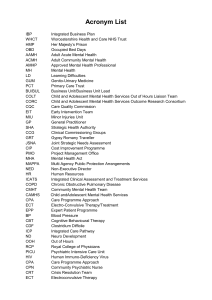Enhanced Commissioning S
advertisement

Enhanced Commissioning [STRATEGY] Brief Description Enhanced Commissioning, as it is described in the LEED documentation is a new requirement for Army buildings. Building commissioning must be performed for new construction and major renovations. Commissioning is a multi-disciplined process of verifying accurate design, installation and operation of all building systems. The commissioning process should begin in the design phase and continues through occupancy and operation. Enhanced commissioning is a set of best practices that go beyond fundamental commissioning to further ensure proper building function. Applications Core spaces HVAC components and equipment HVAC system: interaction of cooling, heating, and comfort delivery systems Building Automation System (BAS): control hardware and software, sequence of operations, and integration of factory controls with BAS Lighting Control System and interface with day-lighting Domestic hot water systems Renewable energy generation systems Building Envelope (separate Army testing requirement) (a) (b) (c) (a) HVAC Components (http://www.archenergy.com/services/commissioning//) (b) BAS Hardware (Source: http://www.alerton.com/resources/?id=67504) (c) Lighting Control System and interface with day-lighting (Source: lightingcontrols.com) Enhanced Commissioning activities that are additional expectations beyond ‘fundamental Commissioning commissioning’ include An independent, experienced commissioning authority (CxA) needs to be designated Tasks1 to lead, review and oversee commissioning efforts, prior to the construction documents phase of the project. The CxA conduct at least 1 commissioning design review of the owner’s project 1 Paraphrased from EAc3 Enhanced Commissioning, USGBC LEED Reference Guide for Green Building Design and Construction, 2009 Edition HIGH PERFORMANCE TECHNOLOGY STRATEGY TEMPLATES (Revision 0, 10-31-2010) Page | 1 These TechNotes are intended to provide general information for the consideration of design strategies. The TechNotes should NOT be interpreted as an endorsement of any specific product or technology. Enhanced Commissioning [STRATEGY] Design Notes requirements basis of design, and design documents prior to the mid-construction documents phase and back-check the review comments in the subsequent design submission. CxA reviews the contractor’s submittals applicable to systems being commissioned. At the same time, the submittals should also be reviewed by the architect or engineer of record. CxA provides a systems manual for future operating staff so they can operate key systems optimally. Training for building operating personnel and occupants is provided and verified by the CxA. CxA reviews the building’s operations within 10 months after completion and develops a plan for resolving outstanding commissioning-related issues. Timeline Engaging a commissioning agent early in the design process can be useful to identify and manage key areas where design and construction decisions will impact building operability. Enhanced commissioning requires a commitment beyond the design and construction phases of the project life, reaching at least a year past building occupancy. Commissioning Authority (CxA) Per the LEED 2009 Reference Guide, the CxA needs to be experienced and independent, which is defined as having commissioning experience on at least 2 other projects. In addition, the CxA cannot be an employee of the design firm, and not an employee of a construction contractor. References/Useful Resources: [1] Federal Green Construction Guide for Specifiers. WBDG. http://www.wbdg.org/ccb/browse_org.php?o=84 [2] Building Commissioning. Evan Mills. http://cx.lbl.gov/cost-benefit.html [3] California Commissioning Collaborative. http://www.cacx.org/resources/providers.html [4] Commissioning Guidelines – Individual Components. http://www.energydesignresources.com/Home.aspx HIGH PERFORMANCE TECHNOLOGY STRATEGY TEMPLATES (Revision 0, 10-31-2010) Page | 2 These TechNotes are intended to provide general information for the consideration of design strategies. The TechNotes should NOT be interpreted as an endorsement of any specific product or technology. Enhanced Commissioning [ENERGY AND ENVIRONMENT] Energy Savings Optimizing Performance Commissioning can reduce repairs, change orders, and maintenance and operational costs. It may yield a substantial reduction in monthly energy demand charges due to the reduction of functional deficiencies. Social Benefits Health and well-being Increased indoor air quality and building occupant’s comfort may be the result of optimized building performance through commissioning. Guiding Principles2 Employ Integrated Design Principles (Commissioning) Employ commissioning practices tailored to the size and complexity of the building and its system components in order to verify performance of building components and systems and help ensure that design requirements are met. This should include an experienced commissioning provider, inclusion of commissioning requirements in construction documents, a commissioning plan, verification of the installation and performance of systems to be commissioned, and a commissioning report. Associated LEED Credits (NC 2009)3 EAc3: Enhanced Commissioning (2 points) Implement, or have a contract in place to implement specific commissioning activities identified in EAc3 in addition to the requirements of EA Prerequisite 1: Fundamental Commissioning of Building Energy Systems. 2 Guiding Principles for Federal Leadership in High Performance and Sustainable Buildings www.wbdg.org/pdfs/hpsb_guidance.pdf 3 USGBC LEED Reference Guide for Green Building Design and Construction, 2009 Edition HIGH PERFORMANCE TECHNOLOGY STRATEGY TEMPLATES (Revision 0, 10-31-2010) Page | 3 These TechNotes are intended to provide general information for the consideration of design strategies. The TechNotes should NOT be interpreted as an endorsement of any specific product or technology. Enhanced Commissioning [PRODUCT AND ECONOMICS] Product Images Duct Leakage (Source: http://cx.lbl.gov) Cost Range Improper Sealing (Source: http://cx.lbl.gov) Building Envelope Moisture Entry (Source: http://cx.lbl.gov) Commissioning costs are typically associated with the size and complexity of the building systems, however, there is likely a minimum and maximum cost associated with typical enhanced commissioning activities. Enhanced commissioning cost estimates would include the incremental costs above fundamental commissioning. In 2004, GSA estimated the incremental costs at $0.10-$0.15 per gross square foot.4 RSMeans5 estimates commissioning to cost 1-1.25% of the total project cost, with the higher value provided as the “maximum.” A recent LBNL study had median commissioning costs at $0.30/ft2-year for existing buildings and $1.16/ft2 for new construction. This new construction commissioning cost was 0.4% of the overall construction cost.6 4 GSA LEED Cost Study: Final Report. October 2004. Prepared by Steven Winter Associates, Inc. th RSMeans Facilities Construction Cost Data, 25 Annual Edition, 2010. 6 Building Commissioning: A Golden Opportunity for Reducing Costs & GHGs. July 2009. Prepared by Evan Mills of LBNL. http://cx.lbl.gov/documents/2009-assessment/LBNL-Cx-Cost-Benefit.pdf HIGH PERFORMANCE TECHNOLOGY STRATEGY TEMPLATES (Revision 0, 10-31-2010) P a g e | 4 5 These TechNotes are intended to provide general information for the consideration of design strategies. The TechNotes should NOT be interpreted as an endorsement of any specific product or technology. Enhanced Commissioning [PRODUCT AND ECONOMICS] Vendors Commissioning is ideally performed by a qualified local provider. Some national engineering firms offer the services and are listed as potential vendors. AEC - Architectural Energy Corporation http://www.archenergy.com/services/commissioning// CH2MHill http://www.ch2m.com/corporate/markets/government_and_commercial_facilities/default.asp or Point of Contact for Ft Bragg commissioning project: Christy Etter (Christy.Etter@CH2M.com or 678.530.4109) AEC http://www.archenergy.com/services/commissioning// HIGH PERFORMANCE TECHNOLOGY STRATEGY TEMPLATES (Revision 0, 10-31-2010) Page | 5 These TechNotes are intended to provide general information for the consideration of design strategies. The TechNotes should NOT be interpreted as an endorsement of any specific product or technology. Enhanced Commissioning [SPECIFICATIONS] Summary for Commissioning Specifications7 Building commissioning activities and documentation in support of the U.S. Green Building Council (USGBC) LEED™ rating program include Fundamental and Enhanced Commissioning services. Documentation for achieving the LEED commissioning prerequisite and EAc3 Enhanced Commissioning would be part of the commissioning contract. Commissioning is a comprehensive and systematic process to verify that the building systems perform as designed to meet the Owner’s requirements. Commissioning during the construction, acceptance, and warranty phases is intended to achieve the following specific objectives: Verify and document that equipment is installed and started per manufacturer’s recommendations, industry accepted minimum standards, and the Contract Documents. Verify and document that equipment and systems receive complete operational checkout by installing contractors. Verify and document equipment and system performance. Verify the completeness of operations and maintenance materials. Ensure that the Owner’s operating personnel are adequately trained on the operation and maintenance of building equipment. The commissioning process does not take away from or reduce the responsibility of the system designers or installing contractors to provide a finished and fully functioning product. Qualifications for Commissioning Agents: Engage commissioning service personnel that specialize in the types of inspections and tests to be performed and have performed commissioning services on at least two building projects. Inspection and testing service agencies shall be members of the Building Commissioning Association. SUBMITTALS A. Commissioning Agent shall submit the following: 1. Basis of Design and Owner’s Project Requirements. Update as necessary during the work to reflect the progress on the components and systems. Forward updates to the Green Consultant in a timely manner. 2. Scoping Meeting Minutes. 3. Submit commissioning plan within 30 calendar days of authorization to proceed. Update as necessary during the work to reflect the progress on the components and systems. Forward updates to the Green Consultant in a timely manner. 4. Submit schedule with Commissioning Plan. Update as necessary during the work to reflect the progress on the components and systems. Forward updates to the Green Consultant in a timely manner. 5. Functional performance test forms: Submit minimum 30 calendar days prior to testing. 6. Deficiency Report and Resolution Record: Document items of non-compliance in materials, installation or operation. Document the results from start-up/pre-functional checklists, 7 Specification language modified from the Whole Building Design Guide’s Federal Green Construction Guide for Specifiers, Section 01 91 00 (01810) - COMMISSIONING. Accessed August 2010 at http://www.wbdg.org/ccb/browse_org.php?o=84 (last updated January 2010). HIGH PERFORMANCE TECHNOLOGY STRATEGY TEMPLATES (Revision 0, 10-31-2010) P a g e | 6 These TechNotes are intended to provide general information for the consideration of design strategies. The TechNotes should NOT be interpreted as an endorsement of any specific product or technology. Enhanced Commissioning [SPECIFICATIONS] 7. 8. functional performance testing, and short-term diagnostic monitoring. Include details of the components or systems found to be non-compliant with the drawings and specifications. Identify adjustments and alterations required to correct the system operation, and identify who is responsible for making the corrective changes. Update as necessary during the work to reflect the progress on the components and systems. Forward updates to the Green Consultant in a timely manner. Final Commissioning Report: Compile a final Commissioning Report. Summarize all of the tasks, findings, conclusions, and recommendations of the commissioning process. Indicate the actual performance of the building systems in reference to the Owner’s Project Requirements and contract documents. Include completed pre-functional inspection checklists, functional performance testing records, diagnostic monitoring results, identified deficiencies, recommendations, and a summary of commissioning activities. O&M Submittals – Training Plan to include Dates, start and finish times, and locations; Outline of the information to be presented; Names and qualifications of the presenters; List of texts and other materials required to support training. COMMISSIONING PROCESS The following activities outline the commissioning tasks and the general order in which they occur. The Commissioning Agent shall coordinate all activities. A. B. C. D. E. F. G. H. I. J. K. L. Design Review and Documentation. 1. Documentation of Basis of Design and Owner’s Project Requirements. 2. Design Development Review. 3. Construction Document Review. Commissioning Scoping Meeting. Commissioning Plan. Submittals Review. Start-Up/Pre-Functional Checklists. Functional Performance Testing. Short-Term Diagnostic Testing. Deficiency Report and Resolution Record. Operations and Maintenance Training. 1. O&M Manual. 2. Training. 3. O&M Database. Record Documents Review. Final Commissioning Report Deferred Testing. 1. Unforeseen Deferred Tests. 2. Seasonal Testing. 3. End-of-Warranty Review. HIGH PERFORMANCE TECHNOLOGY STRATEGY TEMPLATES (Revision 0, 10-31-2010) Page | 7 These TechNotes are intended to provide general information for the consideration of design strategies. The TechNotes should NOT be interpreted as an endorsement of any specific product or technology. Enhanced Commissioning [CASE STUDY] Lawrence Berkeley National Lab Molecular Foundry Berkeley, California Site Location Facility Approach Completed in 2006, LBNL's Molecular Foundry is a state-of-the-art 6-story, 94,500 square foot, $67 million User Facility for Nanoscale Materials, dedicated to supporting research in nanoscience by researchers from institutions around the world. Through the commissioning process during the construction phase of this building, forty-eight specific deficiencies were discovered and was immediately a candidate for additional commissioning efforts after completion and full occupancy. Post-construction commissioning discovered an additional fourteen system deficiencies that were soon corrected. Results HIGH PERFORMANCE TECHNOLOGY STRATEGY TEMPLATES (Revision 0, 10-31-2010) Page | 8 These TechNotes are intended to provide general information for the consideration of design strategies. The TechNotes should NOT be interpreted as an endorsement of any specific product or technology. Enhanced Commissioning [CASE STUDY] Additional Commissioning Case Studies: http://www.cacx.org/resources/commissioning.php?sort=building HIGH PERFORMANCE TECHNOLOGY STRATEGY TEMPLATES (Revision 0, 10-31-2010) Page | 9 These TechNotes are intended to provide general information for the consideration of design strategies. The TechNotes should NOT be interpreted as an endorsement of any specific product or technology.






